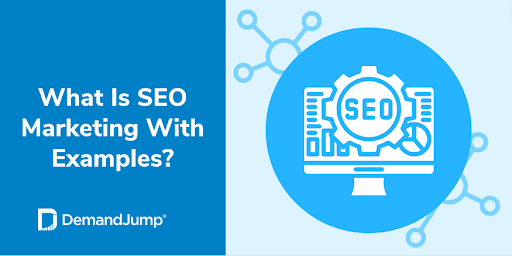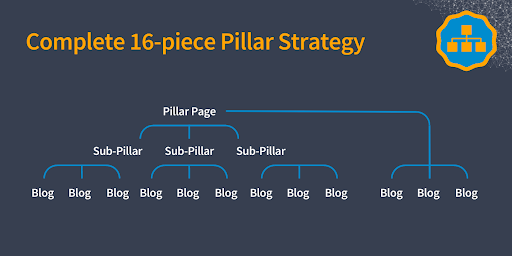What Is SEO Marketing With Examples?
April 18, 2023 •Jeremy Flick

Developing an SEO strategy is essential to boosting organic traffic. Whether you need an SEO plan template, free to use, or would like to build your strategy from scratch, there are a few things you should consider. In this blog we’re going to answer:
- What is SEO, and how is it done?
- What is an example of an SEO strategy?
Let’s deep dive into SEO in marketing and how it impacts your search engine rankings.
What Is SEO in Digital Marketing?
In digital marketing, marketers use SEO tools and techniques to optimize their websites and drive organic traffic. The ultimate goal is to make your website more relevant and easily accessible to your target audience. With digital marketing, in particular, there are techniques you can use to boost your web pages to the top of search results on Google. For example, using high-value keywords throughout your written content will help audiences find your website, because these key terms are what your audience is actually searching for. But that’s just scratching the surface.

Using SEO means developing content that matters. Have you ever read a blog that never answers your question? What about long pieces of content that spin in circles without getting to the heart of what you searched? Unfortunately, it’s all too common for websites to grab your attention and not give you what you want. But SEO in digital marketing can help prevent that. Especially if you do it right. Even Google updated their algorithm to weed out unhelpful content!
But what is the right way? Let’s explore the different components of SEO in digital marketing and how you can implement them into your strategy.
What Are the 5 SEO Elements in Marketing?
At a high level, SEO can be broken down into five components: high-quality keywords, valuable content, content structure, on-page SEO, and off-page SEO.
- High-Quality Keywords | Without the right keywords, it’s pretty difficult for your target audience to find your content. That’s not to say you should stuff your content with keywords in hopes it will rank you higher—in fact, keyword stuffing has the opposite effect. It’s important to use high-quality keywords that people are actually searching for. For example, if you’re interested in SEO and how to implement it on your own website, you might search for the phrase “search engine optimization techniques.” The more people that search a term you use in your content, the more likely it is you’ll get eyes on your content.
- Valuable Content | As we always say, content is king! If you have good, valuable content, everyone is going to want to read your blogs, whitepapers, or other pieces! With helpful content, you’ll see a greater return on investment (ROI), whether that’s through conversions or overall click-through-rates. But content is more than the numbers. If you don’t answer the audience’s questions, you lose authority—and they won’t come back when they have more questions about a similar topic.
- Content Structure | The way you structure content on your site is essential to its success. What do we mean by content structure? Well, at DemandJump, we introduced a revolutionary approach to digital marketing called Pillar-Based Marketing. Rather than post blogs over a wide range of topics, it’s better to create a content cluster—or a group of related content—and link them together in a Pillar structure (more on that later). This means long-form content and Supporting Blogs all fall under the same umbrella. Doing this leads to higher rankings on Google, meaning more organic traffic.
- On-page SEO | On-page components are what digital marketers use to boost the value of their website and content. Whether that’s alt-text for images, meta titles, or header tags, on-page SEO is an important step to optimizing your website. This is not only important to help Google crawl your site, but it also provides a better experience for readers.
- Off-Page SEO | Off-page SEO is exactly what it sounds like: SEO that isn’t related to your website content. Most often, off-page SEO can be found in social media posts or other sites that are not under your domain. Some marketers think backlinks make or break content, but we’ve found increasing organic traffic is more effective when you build a strong brand presence online.
What Is an SEO Strategy That Actually Works?
There’s no doubt that Pillar-Based Marketing (PBM) is the best SEO marketing strategy you can use to boost your organic traffic. By structuring your content using Pillars, Sub-Pillars, and Supporting Blogs, you can create a cohesive group of content that boosts your authority with readers and Google. So what does a Pillar strategy look like? Let’s look at an SEO marketing strategy example using PBM:
First, you start with finding the topic that you want to rank for. Imagine an electronics company called HiFi Components. They want to focus on computer components. Does that seem like a broad topic? That’s good! The first piece of content they need to write is called a Pillar. It’s a comprehensive “ultimate guide”—with 3,000 words and ~20 keywords—that gives a broad overview of computer components, the history of computers, and how they’re used today. That’s a lot of information, but it serves as the end-all-be-all piece of content for your PBM strategy.
The second piece of content in the PBM strategy is called a Sub-Pillar. This piece of content is a bit more focused—like taking a clock from hours to minutes—and delves into the history of computers. How did computers come to be? When were the first personal computers released? All of these questions should be answered in 2,000 words with ~15 keywords. There should be three Sub-Pillars attached to a single Pillar because they’re more specific subjects within a single topic.
The last pieces of content to write are Supporting Blogs. There should be 12 in total, with three connected to each Sub-Pillar and three connected directly to the Pillar. In this case, Supporting Blogs answer very specific questions, like “What was the first personal computer available?” This is a very specific question, rather than the broad Pillar. Supporting Blogs answer the main question in 750 words—with 7-8 keywords.

At DemandJump, we’ve seen amazing success with Pillar-Based Marketing. It’s more than just a structure, it’s an entire search engine optimization marketing strategy, including keywords and content as the anchor points. With insights and the ability to create your own Pillar plan, our platform will help take your content to the top of Google search results, all while tracking your progress. You can also see where you stack up against competitors. The good news is, you can try it for free and experience just how powerful our platform is for your SEO digital marketing.
DemandJump's podcast, Page One or Bust!, discusses in great detail this methodology called Pillar-Based Marketing and how it is shifting the way people think about how to target their ideal customers where they are in their search journey. Check out the below clip from a previous episode, or listen to the full episode at this link.
Featured Articles
Categories
- Attribution Tracking (13)
- Channel Optimization (11)
- Consumer Insights (68)
- Content Marketing (251)
- Data Science (8)
- Digital Marketing (6)
- Digital Transformation (26)
- Enterprise (10)
- Lead Generation (14)
- Market Intelligence (8)
- Marketing Analytics (39)
- Marketing Attribution (57)
- Marketing Management (153)
- Marketing Operations (86)
- Organic Search (222)
- Paid Search (52)
- Pillar-Based Marketing (63)
- Programmatic Advertising (9)
- SaaS Content (14)
- SaaS Marketing (29)
- Search Marketing (111)
- SEO Keyword Research (28)
- SEO Pillar (18)
- SEO Strategy (46)
- SMB (5)
- Website Content (12)


